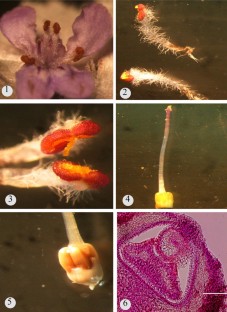Mating strategies in a ruderal weed: case history of Hyptis suaveolens (L.) Poit.
Research Articles | Published: 31 October, 2019
First Page: 564
Last Page: 570
Views: 3883
Keywords: Hyptis , Invasion, Outcrosser, Inbreeding depression, Autogamy
Abstract
Weeds have evolved diverse reproductive strategies to establish themselves in new areas and selfing has proved essential for the preservation of genotype as also for ensuring reproductive success albeit at the cost of reduced genetic diversity. Present study focused on Hyptis suaveolens, is an addition to this context. In sub—tropical climates of Jammu, this species grows as exotic weed and appears as outcrosser on the basis of its floral features, however, details of the floral phenology confirm it to be an inbreeder. This shift of breeding system from outcrossing to inbreeding helps the species for the successful invasion and colonization in new areas which otherwise could have proved unsuitable for its existence. Undesirable side effect however, is low seed set.

References
- Aluri JSR (1990) The explosive pollination mechanism and mating system of the weedy Hyptis suaveolens (Lamiaceae). Plant Species Biol 2:235–241
- Aluri JSR, Subba Reddi C (1996) The explosive floral-mechanism and pollination in the genus Hyptis (Lamiaceae). Proc Indian Natl Sci Acad 62:117–124
- Aluri JSR, Vergara-santana MI, Juarez SL (1997) Floral ecology, Carinal lobe release, pollination and reproductive success in the wild and domesticated forms of Hyptis suaveolens (L.) Poit. Lamiaceae in Mexico. Plant Species Biol 12:61-18
- Armbruster WS, Mulder CPH, Baldwin BG, Kalisz S, Wessa B, Nute H (2002) Comparative analysis of late floral development and mating system evolution in tribe Collinsieae. Am J Bot 89:37–49
- Brantjes NBM, de Vos OC (1981) The explosive release of pollen in flowers of Hyptis (Lamiaceae). New Phytol 87:425-423
- Charlesworth D (2006) Evolution of plant breeding system. Curr Biol 16:26–35
- Cruden RW (1977) Pollen ovule ratios: a conservative indicator of inbreeding system in flowering plants. Evolution 31:32–46
- Grant V (1971) Plant speciation. Columbia University Press, New York
- Harley RM (1988) Revision of generic limits in Hyptis Jacq. (Labiatae) and its allies. Bot J Linn Soc 98:87–95
- Harley RM, Givlietti AM, Abreu IS, Bitencourt C, Oliveira FF, Endress PK (2017) Resupinate Dimorphy, a novel pollination strategy in two lipped flowers of Eplingiella (Lamiaceae). Acta Botanica Brasilica 31:102–107
- Hickey M, King C (1988) 100 families of flowering plants. Cambridge University Press, Cambridge
- Jurgens A, Watt T, Gottsberger G (2002) Pollen grains number, Ovule numbers and pollen ovule ratios in Caryophylloideae: correlation with breeding system, pollination, life form, style number and sexual system. Sex Plant Reprod 4:279–289
- Keller S, Armbruster S (1989) Pollination of Hyptis capitata by Eumenid wasp in Panama. Biotropica 21:190–192
- Mahy G, Jacquemart AL (1999) Early inbreeding depression and pollen competition in Calluna vulgaris (L.) Hull. Ann Bot 83:697–704
- Mudgal V, Khanna KK and Hazra PK (1997) Flora of Madhya Pradesh II. Botanical Survey of India 403–404
- Nowick JW, Epling GC (1969) Part IX, family 169, Labiatae. Ann Mo Botanical Gard 56:71–111
- Pysek P, Richardson DM (2007) Traits associated with invasiveness in alien plants: Where do we stand? In: Nentwig W (ed) Biological invasions, ecological studies 193. Springer- verlag, Berlin, pp 97–126
- Schoen DJ (1982) Male reproductive effort and breeding system in an hermaphrodite plant. Oecologia 53:255–257
- Sharma N, Koul P, Koul AK (1990) Reproductive biology of Pantago. I. Breeding and meiotic systems of Plantago patagonica Jacq. Proc Natl Acad Sci B56:199–204
- Small E (1988) Pollen Ovule pattern in the tribe Trifolieae (Leguminosae). Plant Syst Evol 160:195–205
- Yoganarasimhan SN (2000) Medicinal plants of India. Bangalore Cyber Media 11:282
- Zhang C, Irwin RE, Wang Y, He YP, Yang YP, Duan YW (2011) Selective seed abortion induced by nectar robbing in the selfing plant Comastoma pulmonarium. New Phytol 192:249–255
Author Information
Department of Botany, University of Jammu, Jammu, India